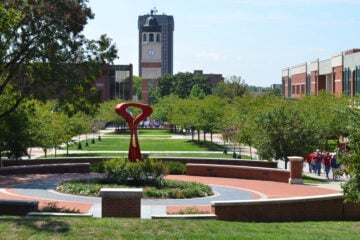NPR data shows staff diversity holding steady as voluntary turnover improves

Ted Eytan / via Creative Commons
Representation of people of color within NPR’s workforce has remained relatively flat since last fiscal year, according to FY2024 data shared Tuesday during a meeting of the NPR board’s DEI committee.
The NPR board’s development committee also met Tuesday to get an update on digital fundraising efforts.
The DEI data also showed that voluntary turnover among employees of color fell to 1.63%, a drop from the previous four fiscal years, during which voluntary turnover was 6.8% or higher.
“Market dynamics play a part in that,” said Darryl Walston, NPR’s interim chief people officer, during the meeting. “But I think as we’ve seen from our most recent climate survey results, there’s a certain level of attachment that our staff here have to NPR. The brand is strong, and we’ve done a lot of great work in the past year and a half.”
Walston credited the lower turnover to the network’s twice-monthly antiracism talks among staff, Start Talking About Race (STAR). He also cited employee resource groups and efforts by Chief Diversity Officer Keith Woods and VP of DEI Whitney Maddox in partnership with the network’s People team “to just try to make sure we’re hearing the feedback and then we’re taking action on it. I think that’s been an overall net positive for the organization and for our demographic data that we have here.”
Voluntary turnover among all staff was 3.86% in FY24, down from a high of 12.4% in FY22.
People of color accounted for 42% of NPR’s full-time staff in FY24, down 1% from FY23 but up from 35% in FY20, the earliest period for which Walston shared data. Of the network’s hires in FY24, 46% were people of color.
In FY24, the full-time staff was 57% female, 43% male and 1% trans, nonbinary or gender-nonconforming. That was the highest share of female employees in the last five fiscal years.
More than 5.4% of staff have a disability, the highest share since NPR began collecting that data in FY22.
NPR’s staff is about 57% white, 16% Black, 13% Asian, 9% Hispanic or Latino, 4% two or more races, and less than 1% for both Native Hawaiian/Pacific Islander and American Indian/Alaskan Native employees.
The data also showed a slightly higher percentage of supervisors who are white compared to the overall percentage of white employees. Nearly 61% of NPR supervisors are white. However, 50% of NPR’s leadership team is white and more than 29% is Black.
According to the most recent U.S. Census data, NPR’s proportion of white staff was lower than the U.S. population’s by about 18%. The network’s percentage of Hispanic or Latino employees trails the U.S. population by more than 10%.
Among supervisors, there was a slightly higher percentage of Black employees than NPR’s Black employees overall, while Hispanic or Latino staff were underrepresented by more than 2%. Asian staff were underrepresented both among supervisors and in leadership.
Toolkit to aid digital fundraising
During a meeting Tuesday of the NPR board’s development committee, Elyse Poinsett, executive director of digital philanthropy, discussed a digital fundraising toolkit that her team has been developing over the last few years and how it will be implemented during year-end fundraising.
Poinsett's team focuses on fundraising from the 21 million people who use NPR platforms such as podcasts, newsletters and NPR.org, she said.
The team’s toolkit focuses on four strategies to encourage giving from digital users:
- Always On — This tactic means “getting the right person, the right message at the right time for them,” Poinsett said. The two most effective tactics with this approach are a donation block embedded in NPR’s most popular newsletters and a pop-up on NPR.org calling for donations from site visitors.
- Activating in the Moment — This strategy calls for partnering with editorial teams to find “clues that the zeitgeist is shifting in our favor,” Poinsett said. “And we have found that when we lean into those moments, results are really strong.” An example is fundraising around NPR leaving Twitter, which led to a “record-setting fundraising day,” she said.
- Planned Activations — These are essentially digital fundraising campaigns. NPR conducts two annual digital fundraising campaigns per year. It participates in Public Media Giving Days in partnership with PBS, Greater Public, Contributor Development Partnership and stations and holds a year-end digital fundraising campaign.
- Tests on donate.npr.org — Poinsett’s team is working with NPR’s Product team to perform tests on NPR.org’s donation page. “We split people into groups and we put them through slightly different variations of our donation form, and we monitor results,” she said. “The winning test becomes the form for everyone, and then we start a new test.” The tests usually aim to improve the rate at which people complete a gift when they go to the donation form, she said. Last year, NPR drove half a million people to the donation page, but most left the page without donating. “With these tests, if we can improve a fraction of a percentage” of people who make a donation, “that can lead to really significant returns over time,” she said.
Poinsett also provided more details about NPR’s year-end fundraising campaign, which will kick off the week of Nov. 25. The campaign’s primary goal will be to convert NPR fans who have never given into donors, she said.
One strategy will be to lean into donations via Meta platforms Facebook and Instagram. NPR will launch donation options, including peer-to-peer fundraising, on the platforms. Poinsett expects those options to be available in time for Giving Tuesday, Dec. 3.
“We believe that there is room for tremendous growth via social media donation,” she said.
New to this year’s campaign will be the option to give a recurring gift to the NPR Network, she said.
During the campaign, NPR will use messaging around “principles and ethics in guiding our journalism” and highlighting “how we don't cater to special interests.” Those messages have been “a very effective differentiator for us in the market,” Poinsett said. NPR will also message around the need for quality information for the public that is accessible to everyone.
That messaging “tests very well, and it pairs nicely with talking about what 2025 might bring and making sure that people can get the facts,” she said.





